
Belugas, Penguins, & Glacial Melt: An Interview with Zanagee Artis
The devastating impact of climate change is one of the most urgent crises of our time. Working in tandem with white supremacy, colonialism, and patriarchy, climate change negatively impacts everyone but disproportionately impacts communities of color and other marginalized communities.
Just look at the recent flooding in Pakistan: as a country, Pakistan makes up 2.6% of the population and contributes less than 1% to global carbon emissions. Yet, they are currently suffering from catastrophic floods induced by climate change that have covered over a third of the country, leaving millions displaced and thousands dead. Meanwhile, the United States accounts for 4% of the global population, but around 13% of global carbon emissions.
Many of our fiscal projects are youth-led movements to combat climate change and address these disproportionate effects. One of these organizations is Zero Hour, founded in 2017 after a group of students came together to send a message to the older generations of policymakers through massive collective action.
One of these students was Zero Hour co-founder, executive director, and policy director Zanagee Artis, who recently returned from an expedition to Antarctica with Global Choices.
This month, our digital content director Emma Buchman spoke with Zanagee on his recent trip to Antarctica, Antarctica’s role in global climate, and the climate crisis as a whole.
— –
Emma Buchman (Digital Content Director & Blog Editor, MO Foundation):
So first we wanted to know: when was the first time you found yourself drawn to climate justice?
Zanagee Artis (Co-Founder, Executive Director, & Policy Director, Zero Hour):
It was actually after I met two of the other co-founders at Zero Hour. I met Jamie Margolin and Madeline Tew at a summer program in the summer of 2017 and really got interested in climate justice work…
Before that I was involved in sustainability and waste reduction at my school, but never really got into the justice aspect of working on environmental issues and sustainability. When I met Jamie and Madeline, and then later some of our mentors, Natalie Mebane and others who were involved with Zero Hour, I really learned over the course of that whole year leading up to the Youth Climate March what climate justice really was and why climate change and sustainability are such human-centered issues.
Emma:
…Tell us a little bit about Zero Hour – what drove you to form your own organization around climate change?
Zanagee:
So honestly, a lot of different reasons. I didn’t actually have any formal education in the environment until the end of my senior year in high school, which was right before we were doing the march. I knew about climate change and what global warming was, but didn’t really grasp how big of a problem it was and how much it was already affecting people all over the world.
So I wanted to take action on systems and to really think about how we could take action collectively to address climate change, this systemic problem around the world. And as we started to learn more about climate justice, also understanding that that was tied to systems of oppression. That was the baseline of our platform: identifying capitalism, colonialism, racism, and patriarchy as the root causes of climate change.
And then it was also timing. The summer of 2017 was the summer after President Trump was inaugurated; it was also a summer that we were seeing a lot of wildfires happening on the West Coast (which at the time were record-breaking, but now we’ve exceeded that year after year). EPA rollbacks and other things were happening then [too]. We were all too young to vote in that election, and [we] wanted to get together with others who felt the same – we wanted to take climate action. We didn’t have an opportunity to use our voices in the election, but we could take to the streets. And that’s why we decided to do the March.
We also recognized that there was a need for a space in the movement that was youth-led. So we continued to have an organization out of the March.
Emma:
I love that… So, the third question is (this is the one I’m very excited to ask!): you recently went to Antarctica with Global Choices. How did you feel when you found out you were going?
Zanagee:
Honestly, it was really amazing! I had done an Instagram takeover with Global Choices the summer before I applied to go to Antarctica, because in one article somewhere I mentioned that I was interested in Arctic issues; and I had never actually worked on any issues related to the Arctic because [Zero Hour is] just focused on the contiguous [U.S.] states, and we don’t have chapters in Alaska.
But it was always fascinating to me – beluga whales were part of my inspiration for getting involved in climate work because they’re at the Mystic Aquarium in Connecticut where I grew up. I talked about this interest in Arctic issues, and they reached out about the Instagram takeover. Then I started following them on Instagram and was just scrolling through one day and saw that they had this opportunity for a young person to go to Antarctica. [I] added a reminder to my phone to come back to it the day before the deadline to submit!
…So, I submitted the [application] and then got through different rounds; and I was getting to the end and I was like, “Maybe this thing is gonna happen,” and then it did! And it was so exciting! I had no idea what it would be like to even think about going to Antarctica, this place where there’s no people and so few people have gone before. It was amazing.
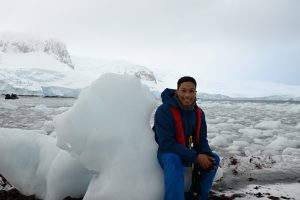
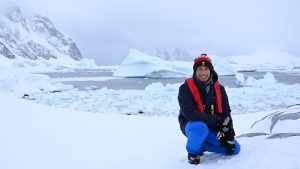
Zanagee Artis on an expedition to Antarctica with Global Choices.
Emma:
…I was curious – could you go into a little bit more about the beluga whales? What about them specifically? They were at the aquarium where you grew up, I’m just curious what about them specifically led you to be inspired by them in fighting climate change?
Zanagee:
Since I was a very little kid, my family brought me to Mystic Aquarium; and there’s several beluga whales there who I think have been there for many years, I think born in captivity. I think it was the first time I ever saw a whale, and it was so different to see that creature, and so amazing. I think it really showed me how much diversity of life there is on the planet.
And to be able to see a beluga that’s from the Arctic in Connecticut of all places! It was so amazing to me. And there were other things at the aquarium too, but specifically the beluga tank was something I was always fascinated by.
Then I started learning more about the Arctic and how belugas are white because they are blending in with the ice there and all these different things about their home environment. And then I started to learn more about global warming and how ice caps were melting, which was “the thing” that people talked about at the time. And I was like, “We need to save the belugas! What are we gonna do if the water warms up too much? Where are they gonna go and where’s their food gonna come from??” That was my first intro to environmental things, was learning about ecology and environments of the Arctic.
Emma:
That’s awesome… Tell us about Antarctica, just anything and everything!
Zanagee:
Yeah, absolutely! We boarded in Ushuaia, Argentina… It was a global expedition, we all traveled there. Ushuaia is the southernmost city in the world, so that was the best place to launch off from. We went in March and in the Southern Hemisphere the seasons are swapped. We were going… it must have been the start of the Fall… There were different ships that went throughout the summer there, ours was the last one of the season! We saw no other people the entire time, it was just us down there.
We got on the ship and set sail. We crossed the Drake Passage, which has some of the highest waves in the world; which was pretty amazing because I was on the bottom level of the ship, and we could see the waves from the porthole. I don’t know if this was the same experience for others, but being on the bottom, you could really see the wave was above us, and that was kind of crazy.
That was a few days that we were on the ship traveling just across the Passage; and then we arrived on the Antarctic peninsula, which is in Western Antarctica. We were all sort of waiting to see our first glimpse of Antarctica, [we were] starting to see icebergs as we were getting closer… Some people saw whales on the way, but I didn’t see any until I got there.
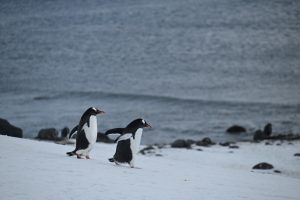
We got there, and each day we did different shore landings, so we would have the ship in the bay and then we’d move around down the peninsula. In each new location we would get out on these little boats called Zodiacs, we’d all go out in different waves and then go to shore.
When we were there we saw penguins, multiple different species. They’re actually quite small, which I didn’t realize! They’re maybe from your knee to your foot, they’re very tiny; but they’re very cute. And honestly, all the animals were not afraid of people; and maybe that’s because they hadn’t ever seen them. But also I think there are less predators in Antarctica than in the Arctic. We saw seals, different varieties of those.
Definitely the highlight for me was seeing whales: we saw humpback whales almost every day; we saw a dwarf minke whale. And this was just while we were out on the Zodiacs, we would sort of drive around and wait to see [them] and then we’d see the blow and we’d kill the engine and just sit there and watch. Sometimes they’d be swimming around, they’d show their fluke as they went down to dive.
And then one time we saw a couple of them just sleeping on the surface of the water; that was amazing, because I didn’t know about whales sleeping. They sleep with half their brain active, and then half of it is resting. They’re actively breathing the whole time and they just rest there on the surface, and that was really amazing. So that’s a few highlights.
Emma:
I never knew whales slept!
Zanagee:
Yeah, right?! So wild!
Emma:
That’s so funny! I love that; that must have been such a unique experience.
Zanagee:
Yeah, and honestly, such solitude – we were the only ones in that whole region of the world, and here we are with these whales that are just sleeping, and I’m sitting around maybe 10 other people on this little boat in the Southern Ocean, and it’s so quiet. Never experienced any sort of quiet like that. It was just amazing.
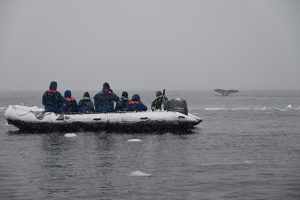

Flip, flop. Photo credit: Zanagee Artis
Emma:
Was the quiet… always a comforting sort of thing or were you aware that there’s no one here for miles, or…?
Zanagee:
Definitely the latter. I was so aware… that it is just us. And that was also a big contributor to bonding there because we all knew that it’s just us and we have each other…
You could hear the waves, sometimes you could hear like ice cracking and there was snow and wind and just… nature, which I think is something that’s very rare now… They call it the “Last Great Wilderness,” because there’s no population that’s consistently there.
Emma:
You already touched on this, but I was wondering if there was another favorite memory or impression that you have from Antarctica?
Zanagee:
Definitely the wildlife; but also, hearing from the people was really powerful. While certain groups were going to shore, some of us were still on the ship and we would rotate around. On the ship, we would have different lectures from different people, and we called it “Speaker’s Corner.” Sometimes we would hear from the expedition people on what species are out there and what we might see today; but most of them were sessions given by other participants on the expedition. I got to hear a lot about people’s stories on why they got involved in climate work, what brought them to Antarctica.
I think storytelling is so key to everything that we do; and especially in a place that has no people, [it’s] really interesting to hear why people care so much about being in Antarctica and protecting places in the world that they call home. That was another big highlight for me.
Emma:
That’s awesome… You were interviewed for Euronews Green, and you gave a little bit of detail about how crucial Antarctica is in the general fight against climate change. Would you mind… going into what you’ve mentioned in that article about why Antarctica is so crucial to the global fight for climate change?
Zanagee:
There’s the Antarctic Treaty, which was signed many years ago now that will actually be up for renegotiation in 2041 and then sort of finalized in 2048… The Antarctic Treaty basically protects different species there from hunting and prevents mining of natural resources on Antarctica for human use. It’s a place that isn’t actually experiencing as much extraction as other places in the world. There are krill fisheries, but otherwise human influence is just climate change.
So why that’s so important is that Antarctica really is a global regulator for the environment. It’s a place that is consistently frozen, and even throughout the summer on days where you might get probably a full 24 hours of sunlight – still frozen!
And then when it’s dark in the winter, the sea ice expands and the ice algae grows, phytoplankton grows, and all these different species are hugely important for carbon sequestration. Antarctic krill sequester hundreds of millions of tons of carbon dioxide every year, and then they’re consumed by whales. Then that whole cycle continues and all of that carbon gets drawn down to the bottom of the Southern Ocean. Even the ocean surrounding Antarctica is important for climate, but the ice sheets themselves are also important for maintaining global climate, maintaining wind patterns, ocean currents.
And the cold there contributes to different things around the world that would change a lot of human activity. So it could be… drought and rainfall in different places just because of different fluctuating temperatures in Antarctica.
And then of course there’s also the worry about sea level rise. There’s a lot of talk about Thwaites Glacier, which has also been called the Doomsday Glacier. It is on the western side of Antarctica and it’s a massive glacier, and if it breaks off from the continent it could cause major sea level rise around the world. Also, when glaciers and ice shelves break off of the continent, it can accelerate flow of ice from the ice sheets. That flow off the ice sheet isn’t replenished as quickly as it’s depleted every year. So that’s another concern because Antarctica is a polar desert, which means that there is no precipitation. There isn’t rainfall or snow that is replenishing the ice sheet. It’s consistently frozen and it doesn’t change. As the temperature warms it’ll be melting, but there isn’t actually rainfall or snow to replenish it, except on the very edges like the peninsula.
Emma:
This is more of a question for me ‘cause I’m curious – what was that cold like? Was it a different kind of cold than cold you’ve experienced before?
Zanagee:
Yes. We wore so many layers every day. It was your base layer, your mid layer, your cover, and then snow pants… it was super cold. Also: did the Polar Plunge and that was crazy. I literally stayed in for five seconds; some people were swimming and I was like, “How are you doing that?”
And then we get out and it’s windy, and I can’t get my clothes on because I’m wet… We did it on the shore and then we got in the boats to go back to the ship, that was a lot… I will always remember that cold… I could swim in the ocean anywhere. Definitely life-changing weather/temperature experience.
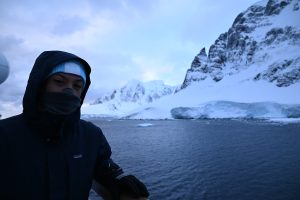
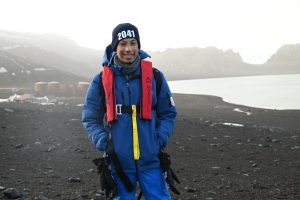
Zanagee and his many layers.
Emma:
…Unfortunately, as you were just mentioning, climate change is here, and we’re already seeing its impacts in terms of the storms, the wildfires. What other impacts do you foresee occurring in the next few years and maybe a decade from now?
Zanagee:
There’s gonna be a lot of different impacts, but I think we’ll start to see more climate disasters in places where we didn’t necessarily think that they were possible. And we’re already starting to see that – for example, a lot of places in Europe experiencing heat waves despite being so far north; places in Russia, in Siberia, experiencing wildfires and heat waves. France experienced this, places in Canada; so we’re starting to see that…
Also, impacts on the economy… People talk about supply chain issues now, but I think that it will not be possible to predict where climate disasters will be happening. Even for battery supplies: talking about the transition to electric vehicles[and] where that lithium is coming from, the Sichuan Province in China… in August, shut down factories throughout the province for a whole week because of a heat wave. There was so much drain for energy on the grid because the citizens needed to have air conditioning. And that caused supply chain issues for lithium for batteries for your Tesla or for whatever electric vehicle. So that, I think, will become more frequent; and that could be for a variety of things, even water. And we’re seeing that where I am in Utah too: talk about concern for long-term water supply.
All over the world we’ll start to see very systematic changes to the way that we operate, and we’ll have to think about adaptation a lot more. We have to be focusing on mitigation and adaptation right now, but I think especially into the future a lot of places that had never considered adaptation because [they] weren’t experiencing as much climate change impact, [they’ll] start to be concerned about that.
Emma:
…We often see in the news deadlines of when we can act against climate change before the impacts become irreversible, and some of those deadlines seem to have already passed by. If you could conceivably give a deadline, a timeline, what would it be?
Zanagee:
This is a really interesting question because this is such a big focus… We did this too, at Zero Hour: our old website used to have this clock that was counting down to 2030… because we viewed that as the tipping point for a lot of different things if the transmission and emission reduction hadn’t happened by 2030. And that’s in line with different timelines from the IPCC [Intergovernmental Panel on Climate Change] and available knowledge about climate disasters happening in the world. Then we saw Sunrise [Movement] with their “11 Years” campaign. And there’s been others, like the Climate Clock.
Those are all really important reminders about the urgency of the problem, but I don’t know that I would assign a date where we really gotta get it done. I think the best time to have done it was yesterday; or the ’80s; or even before that, when we were talking about reliance on coal way back when. But we know what we know now and what we have is today.
I think that that will always be the idea that we have at Zero Hour: we have no time left to act, and that means that now is the time to act. We [aren’t] going to throw up our hands because we’re like, “The clock hit zero, it’s 2030!” We always have to continue to keep going in the now.
Emma:
I remember the first time that I heard climate change was an actual problem was in middle school, and I’m 28 now, so… It’s sickening to me how much time people have wasted…
Zanagee:
The Kyoto Protocol was just passed in the Senate and it got raised in 1997 with the UNFCCC [United Nations Framework Convention on Climate Change]! That’s on hydrofluoric carbons, limiting that and other greenhouse gasses… A lot of other countries were on board with this for a long time, and the United States just decided to do this now…
Emma:
Well that brings me very much into my next question: across the world, we’re already seeing the effects of climate change disproportionately impacting communities of color. Two examples are the flooding in Pakistan and the water crisis in Jackson [Mississippi]. What do we need to do to mitigate these disproportionate effects?
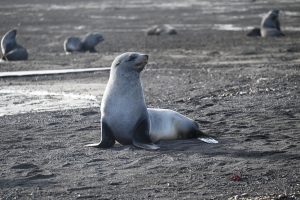
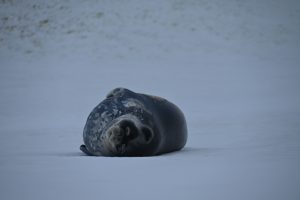
Look at them. Look at how cute they are. Photo credit: Zanagee Artis
Zanagee:
There’s a couple of different things for different regions. On the note of Pakistan: I think that something we’ll be talking a lot about ahead of COP27 [United Nations Climate Change Conference] in Egypt is loss and damage.
Loss and damage is this idea that wealthier countries in the world who have experienced less harm from climate change should be offering funds to accommodate for the losses and damages of countries that have already experienced climate change. And specifically because these wealthier nations have emitted disproportionately more than other places that are being impacted today, that would help a lot, right. It could help with relief for the damages that Pakistan has experienced from flooding, and it could also support adaptation infrastructure for future disasters.
Honestly, in most places in the world that are being impacted by climate change today, and there are some exceptions like Saudi Arabia for example, but for the most part these countries are not producing or exporting fossil fuels. They also aren’t using them in their own nations as much as, say, the United States or Spain or France or other countries in the West that people would consider to be “developed.” So that’s one thing: a loss and damage function facilitated by the United Nations and funded by the member states.
And then within the U.S.: environmental justice policy and funding for places that are already being impacted by issues of environmental injustice and climate change. It’s Gulf South communities facing more infrastructure from export terminals – the export of fossil fuels around the world, its pipeline infrastructure, and its water issues that have been ongoing for a long time in a lot of different places.
People often talk about a distinction between climate justice and environmental justice; but for us, we really think of them as the same issue and it’s just a different kind of impact. Climate justice is environmental justice, and not all environmental justice is climate justice.
So in Jackson, those two things have sort of intertwined and that happens a lot. Pipeline infrastructure for that immediate community might be just an environmental justice issue, but that pipeline carrying those fossil fuels will cause climate change; linking those together is really important.
That’s important to carry through in policy because there’s often a distinction that people will try to make in legislation on that and we like to talk about them in the same way.
Emma:
…What sources of renewable energy do you think will be the most useful and beneficial, and are there any you think would do more harm than good?
Zanagee:
…I primarily work on the fossil fuel supply side more than the advocacy for certain kinds of renewables, but as I learn more about this, a lot from different partners and coalitions from other nonprofits, wind and solar will probably be the number one renewable energy options. We’ve done the most research and development in wind and solar, and the resources for them are more available than, say, hydrogen… And that’s also dependent on places in the world; but, there’s either wind or solar almost everywhere! And there’s offshore options.
The biggest concern I think for wind is connection to the grid. For example, in the U.S. there’s so much wind in the Great Plains region, but there’s more wind capacity than energy demand. We would need to have a way to link that wind energy to the coasts for it to be the most impactful.
There’s also opportunity for solar and throughout the U.S., some of the less sunny places will have to think a lot about options for energy storage. But for the most part, those two will be really strong.
And then depending on the place, hydropower. That will also have a lot of different ecological impacts, depending on the kind of infrastructure that might be decided on. Dams will for sure – it would cause flooding in different places. But there are dams throughout China that are powering so much of the country, there’s different options there.
I think that two that will probably do more harm than good, which a lot of people in the environmental community have advocated, are hydrogen and nuclear. I think green hydrogen could be really interesting; basically green hydrogen separates the hydrogen molecules from water through electrolysis, so the only emission is the oxygen. If that’s powered by renewable energy, then it’s 100% renewable. But a lot of what the fossil fuel industry has proposed is hydrogen from methane… there’s four hydrogen molecules [in methane] and they want to split that off, which would mean they’d have to get the methane from fracked gas, which sort of defeats the purpose of the renewable part. We know that there’s methane leaking from fracking wells already, and we also know that that’s an environmental justice concern for communities and water and all these things.
And then nuclear, well… there’s radioactive uranium where we don’t know where to put it, and the halflife is like 4.5 billion years… That’s also an environmental justice concern, because we keep sticking uranium in Yucca Mountain in the southwest of the U.S, which is on Indigenous lands. People have opposed that for a really long time. There’s really no actual viable storage site for uranium because everyone is like, “We don’t want radioactive waste near us.” Which, valid! We have nowhere to put it, so those two for sure.
Emma:
I’m a Chernobyl person… I read contemporary articles to the accident, and a lot of them mentioned the protests that came up immediately after from environmental activists specifically about that, about the contamination from Chernobyl; as well they should have been because it was 500 atomic bombs worth of radioactivity!
…Is there anything that Zero Hour’s up to that you’d like to share?
Zanagee:
A couple big things! We’re still advocating for the Biden Administration to end fossil fuel leasing. That’s a really big thing that sort of changed a bit since the Inflation Reduction Act passed, because it actually mandates some new fossil fuel leasing. But we believe that the president should declare a national climate emergency and use the powers of the executive office to halt that fossil fuel leasing, to halt new fossil fuel infrastructure, and also do more to eliminate fossil fuel subsidies. Fossil fuel subsidies essentially exist in many different forms, but at [their] root, they’re funds given by the government to the fossil fuel industry to operate and produce fossil fuels. We don’t think that tax dollars should support that, because we know that climate change is impacting taxpayers negatively and the government is meant to act in the public’s interest.
We’re also getting ready for the election, fun, fun, fun! Election day, November 8th, we are gonna be working on registering young people to vote, getting people out to vote… getting excited for that. Young people especially have to get out to vote for climate specifically. There are very few people who are environmental or climate voters as their number one issue, but I think as we see more of these issues coming up related to our environment, more people will prioritize that as an issue. We’re pushing people to do that, because environment is the baseline of all other issues. So get ready to vote!
Emma:
The only other question I had was if someone was interested in starting their own journey into climate justice and they don’t know where to start, or if someone just wants to make a change in their own life to contribute to climate justice, what would you suggest?
Zanagee:
…It depends on how much someone wants to get involved; but becoming an activist, I think anyone can be an activist, that really just means using your voice to advocate for change. You could join a local organization, you could start a Zero Hour chapter in your area if there isn’t one already; Sunrise has different hubs across the country.
Look at what your city is doing on sustainability, what your state is doing. There are public comment periods all the time for different proposed things like gas pipelines and drilling projects. Anyone can find that public commentary and write a comment on why they think it shouldn’t happen. City council meetings are open; your town hall, all these things that many people often don’t know about. You can search your city website and see if they’re talking about climate.
The other thing I think that’s very accessible is personal finances. Where you decide to do your banking is also really important for sustainability: different banks will use the money that you have in your account to invest in fossil fuels. Chase Bank is one of them, so if you have a Chase debit card; or Bank of America, different major banks. You can see if your own invests in fossil fuels and how much and decide to personally divest from that. You can transition to a credit union or some other local bank option. They’re also national banks that don’t invest in fossil fuels, like Aspiration. I have an Aspiration card, it’s really great! You get rewards for sustainable products (not sponsored!).
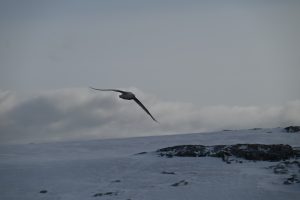
Social media, huge thing, another entry level thing. Just learning more and having your own climate justice education journey… Social media was super helpful in learning a lot of different things and different issues. Some people haven’t heard about the floods in Pakistan; I heard about them first on Twitter, I wasn’t hearing it from the news. Networks of people and environmentalists online, super helpful to learn.